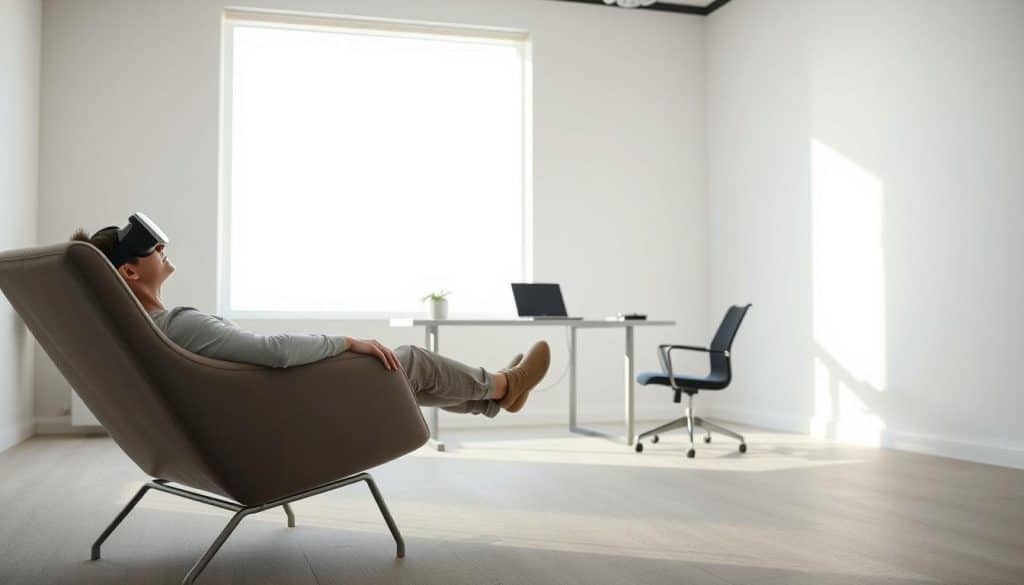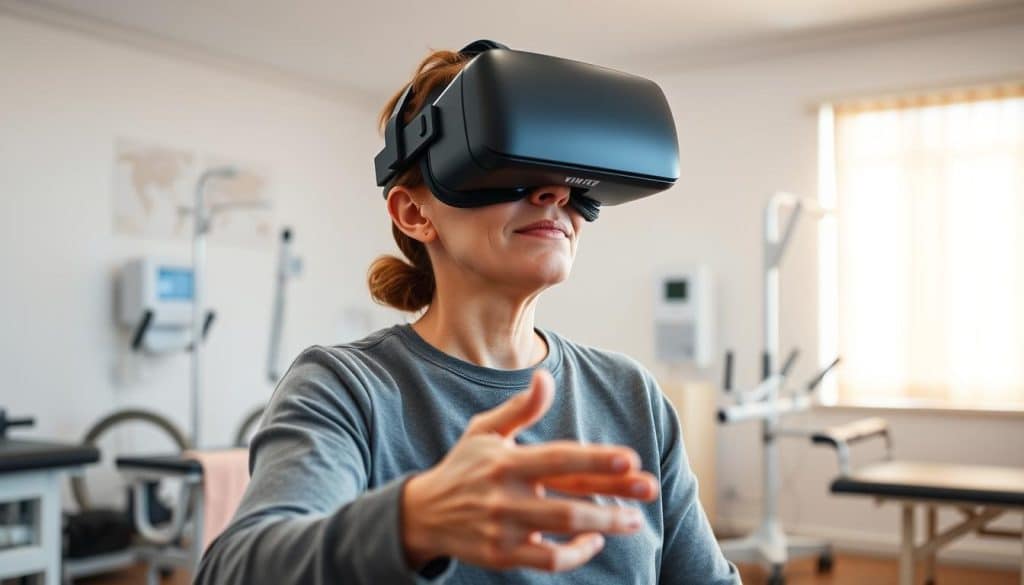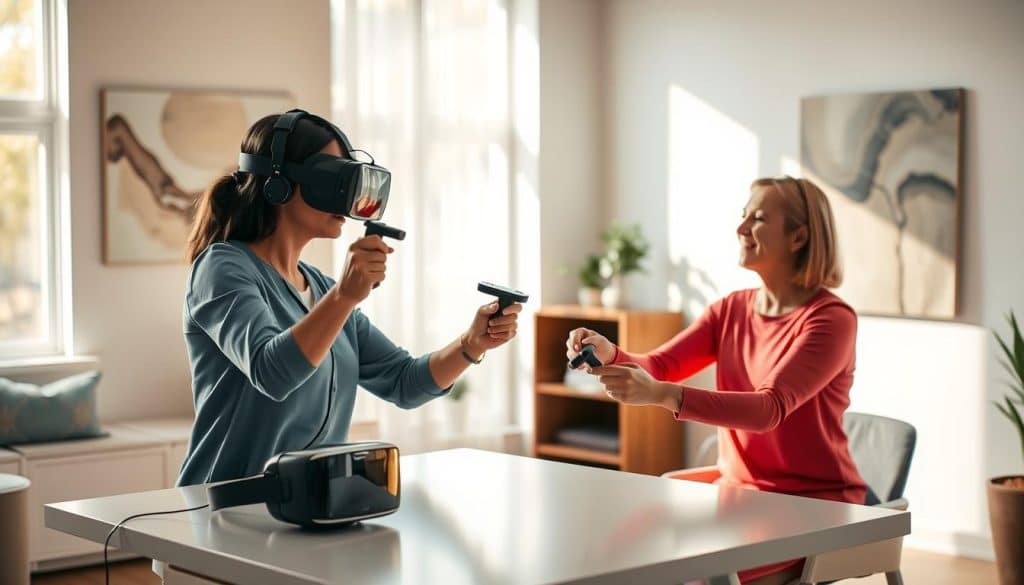Did you know patients using immersive tech during therapy sessions show 30% faster recovery rates in motor skill development? At Riverside Sports Therapy, we’ve harnessed this groundbreaking approach to redefine care in Calgary.
Once limited to gaming, advanced systems now create tailored 3D environments for rebuilding strength and coordination. These tools let you interact with lifelike scenarios while therapists track progress in real time.
Our clinic prioritizes methods backed by research. By merging human expertise with tech precision, we deliver consistent, measurable results. Every session adapts to your unique needs, whether recovering from injury or managing chronic pain.
Key Takeaways
- Immersive environments boost engagement and accelerate recovery timelines.
- Standardized therapy settings ensure repeatable, controlled treatment plans.
- Modern tech evolved from simple visuals to precise medical-grade tools.
- Personalized programs address conditions from mobility issues to neurological challenges.
- Riverside integrates innovation to lead Calgary’s rehabilitation landscape.
Overview of Virtual Reality in Rehabilitation
Imagine rebuilding strength while navigating a digital forest or calming ocean waves—all within your therapy session. This isn’t science fiction—it’s how modern clinics enhance recovery. By merging interactive 3D environments with clinical expertise, therapists create targeted exercises that feel more engaging than traditional methods.

Research shows multisensory stimulation improves neural connections critical for regaining mobility. Studies across Canada reveal measurable progress in conditions like Parkinson’s and stroke recovery when using these tools. Customizable scenarios allow adjustments based on your daily performance, keeping challenges aligned with healing milestones.
Why does this approach work? It taps into your brain’s ability to adapt through repeated, goal-oriented tasks presented in stimulating formats. Clinicians monitor responses in real time, blending tech insights with hands-on care for optimal results.
The Evolution of VR Technology in Therapy
What began as clunky headsets in research labs now powers life-changing recovery programs. Early systems focused on basic visual simulations, but today’s tools blend precise motion tracking with adaptive challenges tailored to your progress.
History and Milestones
In the 2000s, scientists discovered interactive 3D environments could rewire neural pathways faster than traditional exercises. Breakthrough studies proved patients regained motor skills 40% quicker when using gamified tasks. Gaming companies then shared motion-sensing tech, letting clinics create affordable systems.
By 2015, over 200 peer-reviewed papers validated these methods for stroke recovery and balance training. This shifted focus from “can it work?” to “how can we optimize it?” Therapists began prioritizing measurable outcomes over novelty.
Modern Developments and Trends
Current systems use AI to adjust difficulty mid-session based on your performance. Wireless headsets eliminate tripping hazards, while haptic gloves simulate real-world textures. Clinics now combine these tools with biometric sensors for holistic progress tracking.
At our Calgary center, we’ve adopted modular software that updates weekly with new exercises. This ensures you access the latest methods proven in global trials. From Parkinson’s support to post-surgery rebuilding, tech now serves your goals—not the other way around.
Technology Behind Immersive Rehabilitation Systems
Your therapy experience is powered by layers of technology working seamlessly behind the scenes. Three core elements drive these systems: immersion, presence, and interaction. They combine visual, sound, and touch feedback to create environments that feel real while supporting your recovery goals.
Immersive and Interactive Environments
Tech tiers range from tablet-based setups to full sensory engagement. Non-immersive systems use basic screens for guided exercises—ideal for early-stage recovery. Semi-immersive options project interactive scenes on large displays, letting you focus on movements while staying aware of your surroundings.
Complete immersive setups wrap you in 360-degree digital worlds through headsets or room-scale projections. These advanced tools track precise body motions, adjusting challenges as you improve. Haptic gloves add texture sensations, making virtual objects feel tangible during tasks.
Commercial and Custom VR Solutions
Many clinics repurpose gaming consoles for affordable motion tracking. These commercial tools work well for balance practice or coordination drills. However, custom-built systems offer deeper clinical integration—think real-time muscle activity monitoring or progress-tracking dashboards for therapists.
At our Calgary center, we blend both approaches. Off-the-shelf tech handles routine exercises, while proprietary software manages complex cases. This hybrid model ensures cost-effectiveness without compromising precision for specialized needs.
Virtual Reality Applications in Rehabilitation
Have you ever experienced therapy that feels like play? Modern tools transform repetitive exercises into dynamic challenges tailored to your recovery journey. From rebuilding hand-eye coordination to managing chronic discomfort, interactive systems adapt to your unique needs while tracking measurable progress.
These solutions address diverse conditions, including stroke recovery and spinal injuries. For example, balance training might involve catching virtual objects while standing on uneven surfaces. Cognitive exercises could challenge memory recall through interactive puzzles—all within controlled, adjustable environments.
Therapists blend these tools with conventional methods for comprehensive care. Imagine practicing walking patterns in a simulated park while your clinician monitors joint angles. Real-time adjustments keep tasks challenging yet achievable, maintaining motivation throughout your program.
Customization extends beyond physical tasks. Anxiety management programs use calming nature scenes paired with breathing exercises. Post-surgery patients regain strength through gamified strength drills that feel less like work and more like accomplishment.
Our Calgary clinic prioritizes tech that evolves with you. Weekly software updates introduce fresh scenarios, preventing plateaus and keeping sessions engaging. Whether recovering from trauma or enhancing mobility, every experience aligns with your evolving capabilities.
Benefits of VR for Patient Treatment
What if therapy could feel less like a chore and more like a stepping stone to recovery? Modern tech transforms repetitive exercises into purposeful activities that keep you engaged. This approach helps maintain consistency—a critical factor for lasting results.

Pain Management and Motivation
Distraction-based environments reduce discomfort during challenging sessions. Studies show calming nature scenes or puzzle-solving tasks lower pain perception by 37%. This lets you push limits without discouragement.
Gamified challenges trigger dopamine release, creating positive reinforcement loops. You’ll find yourself wanting to beat high scores rather than counting minutes. Therapists use this natural drive to extend session durations organically.
Improvement in Motor Skills and Balance
Interactive systems rebuild coordination through real-world simulations. Catching floating objects strengthens hand-eye responses. Walking on virtual uneven terrain sharpens stability control.
- Instant feedback corrects posture during movements
- Adjustable difficulty matches your progress pace
- Multi-sensory cues enhance neural adaptation
These methods prove particularly effective for stroke recovery. Patients regain daily living skills 22% faster compared to conventional drills. Each achievement builds confidence for real-world application.
Enhanced Therapist Efficiency and Empathy
Modern tools transform how therapists deliver care while deepening their understanding of your journey. By automating routine tasks, specialists gain more time to focus on what matters—your progress. Customized programs emerge faster through adaptive algorithms that analyze your movement patterns and response rates.

Real-time data dashboards help clinicians spot trends instantly. They adjust difficulty levels during sessions based on your performance metrics. This precision reduces guesswork while maintaining optimal challenge levels for steady improvement.
Empathy grows through perspective-shifting simulations. Clinicians temporarily experience mobility limitations through controlled scenarios. These insights help them design exercises that respect your daily struggles while pushing achievable boundaries.
Three key benefits emerge:
- Automated progress tracking cuts documentation time by 40%
- Shared visual feedback makes goals tangible during sessions
- Multi-patient monitoring maintains personalization at scale
Your therapist becomes both guide and collaborator. They interpret data patterns to celebrate small wins you might overlook. This balanced approach keeps rehabilitation engaging while ensuring clinical effectiveness at every stage.
Customization of Therapy for Individual Needs
Tailoring recovery plans isn’t just a goal—it’s the foundation of effective care. Unlike traditional methods using fixed routines, VR systems assess your movement patterns and adjust challenges dynamically during exercises. This ensures every session matches your current abilities while gently pushing boundaries.
Therapists modify scenarios in real time based on performance data. If a balance exercise feels too easy, the system introduces uneven terrain. For cognitive rebuilding, puzzle difficulty scales with your progress.
At Riverside Sports Therapy, customization extends beyond physical tasks. Emotional states and motivation levels shape session designs for patients. A calming beach scene might ease anxiety during stretching, while competitive games drive effort in strength drills.
By prioritizing adaptability, we ensure every patient’s rehabilitation journey remains focused on measurable progress. Your program evolves as you do, creating a path that feels uniquely yours.
